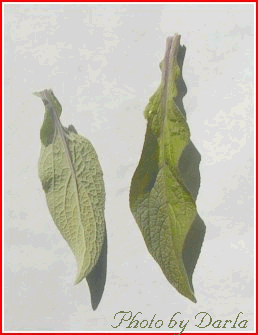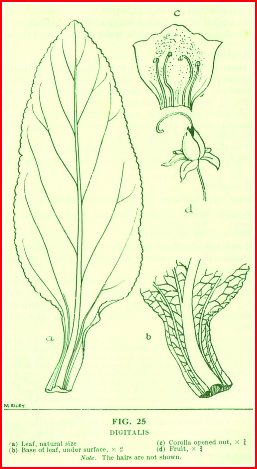

Digitalis BP
Martindales 24th
Compiled and edited by Ivor Hughes
Related Links
Foxglove Monograph
Digitalis Leaf (B.P., I.P.). Digit. Fol.; Digitalis; Foxglove Leaf;
Feuille de Digitale; Fingerhutblatt; Hoja de digital.
Dose: See under Uses.
Foreign Pharmacopoeias: In all pharmacopeias examined, most of which specify not less than 10 units per g.
The dried leaves of Digitalis purpurea (Scrophulariaceae). Digitalis leaf contains a number of glycosides, including digitoxin, gitoxin, and gitalin. Aqueous preparations of digitalis, such as infusions and mixtures, are very unstable. Protect from light and moisture.
Note. When Digitalis, Digitalis Folii Pulvis, Digitalis Folium, Digitalis Leaf, Powdered Digitalis Leaf, or Pulvis Digitalis is prescribed, Prepared Digitalis is dispensed.
Toxic Effects.
Fatalities from massive oral administration are rare since vomiting usually sets in, but death has occurred from as little as 2.5 g.Nausea, salivation, vomiting and anorexia are among the earliest symptoms of digitalis overdosage; diarrhoea and abdominal pain may also occur. Certain cerebral effects are also early symptoms of digitalis overdosage; these include headache, malaise, drowsiness, disorientation, mental confusion, and aphasia. Blurring of vision may occur, and there may be disturbance of colour vision, objects appearing yellow or green. Various disturbances of cardiac rhythm occur as a result of over dosage and the development of extra systoles, pulsus bigeminus, partial or complete heart-block or ventricular tachycardia are indications for discontinuing treatment; ventricular fibrillation is the commonest cause of death from digitalis poisoning. Toxic reactions to the drug may be precipitated if there is potassium depletion, which may be caused by mercurial diuretics.
Antidotes.
For acute poisoning, empty stomach by emetic or stomach tube (if copious vomiting has not already occurred), keep patient lying down and give symptomatic treatment. For poisoning due to cumulative action, suspend digitalis treatment temporarily and give castor oil to prevent further absorption from the alimentary tract.Potassium salts should be administered orally, usually as the acetate or chloride, in doses of 2 to 10 g. daily if renal function is normal. Ventricular arrhythmias refractory to potassium may be controlled by intravenous injection of 15 to 20 ml. of a 20% solution of magnesium sulphate, but owing to its unpleasant side-effects, the use of magnesium sulphate should be confined to refractory arrythmias. When renal function is impaired and the use of potassium salts contra-indicated, procainamide hydrochloride may be given orally in doses of 0.5 to 1 g. every four to six hours, but it should be used with caution, and intravenous administration should be reserved for critically ill patients.
Contra-indications.
Digitalis is contra-indicated in ventricular tachyrardia, and in sinus tachycardia, unless there are definite signs of congestive failure Caution should be exercised, and large doses avoided, in acute lesions of the myocardium, such as rheumatic carditis and cardiac infarction. Digitalis should be withheld in pneumonia and in angina pectoris unless heart failure is present; it is contra-indicated following an acute coronary thrombosis unlessheart failure ensues. In shock or in peripheral circulatory collapse occurring in the course of acute infectious diseases, digitalis may further decrease cardiac output and thus aggravate the syndrome.

For the reason
, if congestive failure occurs in a diphtheritic heart, digitalis should be employed in smaller doses than usual. It should be used with caution in partial heart-block, but in complete heart-block it can be given freely. Injection of calcium salts should not be given during digitalis therapy, and the drug should be given cautiously to patients receiving parathyroid extract or large doses of vitamin D.Uses.
The main property of digitalis is its ability to increase the force of the myocardial contraction. Other responses to digitalis, such as slowing of the heart-rate, increase in cardiac output, decrease in cardiac enlargement, reduction in venous pressure and improvement in renal function, are all explained on the basis of this action.The most important indication for the use of digitalis is congestive heart failure. The increased force induced by digitalis results in more complete emptying of the ventricle at systole, and correspondingly greater output per beat. Venous pressure is lowered because the heart is capable of dealing with an increased venous return of blood. Not only is the force of systole increased, but its length is shortened, giving the heart more time to rest between contractions and more time for the ventricle to fill with venous blood.
Owing to the increased cardiac output there is improvement in the peripheral circulation, with mobilisation of oedema fluid, improved renal blood flow, and resultant diuresis. Since the diuretic action of digitalis is entirely the result of its action on the heart and circulation, the drug will not improve renal function unimpaired by faulty circulation, or remove oedema not due to heart failure.
In digitalised patients
in whom an advanced degree of oedema persists, mersalyl intramuscularly is a valuable adjuvant for the promotion of diuresis. Once digitalis has been given for congestive failure, the patient will usually need maintenance therapy for life.Auricular fibrillation was at one time thought to be the main indication for the use of digitalis; it is now appreciated that it is the cardiac failure and not the disordered rhythm which is of primary importance. If there is no heart failure little effect on the ventricular rate may he noted; indeed, in toxic cases without failure, as in thyrotosicosis and diphtheritic heart disease, it may even be harmful.
It is in auricular fibrillation due to congestive heart failure that digitalis produces its most dramatic results. In the majority of cases, the abnormal rhythm is not abolished but the ventricular rate is slowed, and owing to the cardiovascular action of the drug there is an increase in the force of ventricular systole, the combined action resulting in a general improvement in the condition.
Digitalis is also used to convert auricular flutter to auricular fibrillation; on cessation of digitalis therapy normal sinus rhythm may be restored.
In paroxysmal auricular tachycardia, digitalis may relieve or prevent an attack, but in paroxysmal ventricular tachycardia its use is dangerous even in undigitalised patients, and is indicated only if heart failure develops.
Blood pressure is affected by digitalis only through the action of the drug on the heart and not by any significant effect on the blood vessels or vasomotor centre; low pressures due to decompensation are raised to normal as digitalis improves cardiac function.
Digitalis is eliminated slowly from the body, and with repeated doses cumulative effects occur, eventually resulting in digitalis poisoning. It is therefore important to know before administering the drug whether a patient has previously been receiving digitalis. A single dose of digitalis given by mouth is usually absorbed within 2 hours and exerts its full action on the heart within 6 hours, the cardiac action persisting for several days to 3 weeks or more.
The oral route
of administration is used whenever possible, as it is the safest, and beneficial results are sufficiently rapid except in cases of emergency. It is usually given at mealtimes, either as the tincture or as the powdered leaf in tablets, preferably the latter. The dose required is usually based on the body weight of the patient. Thus, for an adult of 10 stones a total dose of 2�1 g. (32 grains) of prepared digitalis, or 21 ml. (315 minims) of Tincture of Digitalis is necessary. For rapid digitalisation in urgent cases, this is given over 24 hours, half the total dose being given initially and the remainder in divided doses at 6-hourly intervals. This massive dosage should not be employed if digitalis or an allied drug has been taken within the previous 10 to 14 days.The patient may be digitalised more slowly by giving the total dose in divided doses spread over 2 to 4 days, usually m doses of 200 mg. (3 grains) of prepared digitalis or 2 ml. (30 minims) of the tincture three times daily for 2 days, then half or two-thirds of that dosage for 2 or 3 days.
The effects of digitalis can only be maintained when the drug is given in excess of the amount excreted daily-. It is impossible to employ any rule of thumb method in assessing the daily maintenance dose required as it varies with each patient and depends on the level of digitalis action desired. It is usual to aim at a constant concentration of digitalis in the system sufficient to Produce a pulse-rate of approximately 60 beats per minute. This is usually achieved by a dosage of the order of 60 to 200 mg. (1 to 3 grains) daily of prepared digitalis, or of 0.6 to 2 ml. (10 to 30 minims) of tincture.
If digitalis cannot be given orally the tincture may be given by rectal injection, or suppositories of powdered digitalis may be employed; the doses, intervals between doses, and the time necessary to obtain cardiac effects are the same for rectal as for oral administration. In cases of acute emergency an intravenous injection of digoxin may be given; this produces an effect on the heart-rate within 15 to 30 minutes.

Prepared Digitalis (B.P., I.P.).
Digit. Praep.; Powdered Digitalis; Pulvis Digitalis Folii Standardisatus (I.P.); Digitalis Pulverata.Dose: 30 to 100 mg. (0.5 to 1.5 grains).
Foreign Pharmacopoeias: Similar standardised powders
(10 units per g.) are included in Egyp., Ind., Alex., Span., Swiss, and U.S.
Digitalis leaf reduced to powder, no part being rejected, and biologically assayed the strength being stated in units per g. For therapeutic purposes it must be adjusted to contain 10 units in 1 g. (1 unit in 100 mg.). It may be adjusted by admixture with a weaker prepared digitalis, with the dried exhausted marc from the preparation of Tincture of Digitalis, with powdered lucerne, or with powdered grass. I.P. allows admixture with rice starch. Protect from moisture.
Capsules
Infusion
Dose:
30 to 120 ml. (1 to 4 fl. oz) for single administration; 6 to 20 mil. (90 to 300 minims) for repeated administration.The infusion has such practical disadvantages that its use should now be abandoned.-C. Hoyle and J. W. Linnell, Practitioner, 1936, 136, 94.
Mixtures
Dose: 15 ml (0.5 fl oz.) twice or thrice daily in water, as directed.
Mist. Digital. et Caffein. (N.F. 1939). Tincture of digitalis 7.5 m., caffeine 1 gr., solution of strychnine hydrochloride 3 m., concentrated infusion of orange peel l. m., water to 0.5 fl oz. Dose: 15 ml. 0.5 fl. oz.).
Mist. Digital. c, Scill. (N.F. 1939). Tincture of digitalis 5 m., tincture o( squill 10 m., potassium acetate 10 gr., chloroform water to 0.5 fl oz. Dose: 15 ml. (0.5 fl oz.).
Pills
Tablets
Tablets of Prepared Digitalis (B.P.). Tab. Digit. Praep.; Tab. Digit. (B.N.F.); Digitalis Tablets Unless otherwise specified 1-grain tablets are supplied. U.S.P. usual strength,: 30, 60, and 100 mg. Protect from moisture.
Tinctures
Digitalis Tincture (U.S.N.F.). Prepared from digitalis, about 1 in
10, by percolation with a mixture of alcohol l vol. and water 1 vol., and
adjusted to contain 1 unit per ml. Dose: 1 ml. 5 to 15 minims).
Similar tinctures are included in most foreign pharmacopoeias.
STABILITY.
On storage, tincture of digitalis loses potency (20 to 30% in 1 year, determined by an intravenous method in frogs) due to hydrolysis of primary to secondary glycosides. Tinctures prepared from leaf stabilised by treatment with alcohol under pressure prior to drying, are not stable, but a solution of digitoxin in alcohol (70%) is stable. F.Fish and J.P. Todd, J. Pharm. Pharmacol., 1954, 6, 894.Tincture of digitalis prepared by 1-hour maceration-gentle agitation
of powdered digitalis with 10 volumes of alcohol (70%)-retains its potency
for at least 5 days and it is recommended that such a preparation be made
extemporaneously from standardised leaf powder when tincture of digitalis is
prescribed.- J.M. Rowson, J. Pharm. Pharmacol., 1955, 7, 924.
Related Links
Foxglove Monograph
![]()